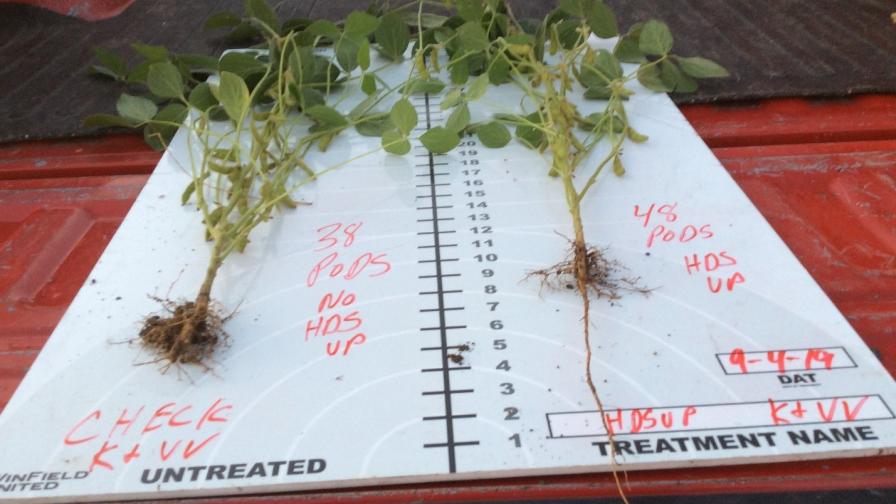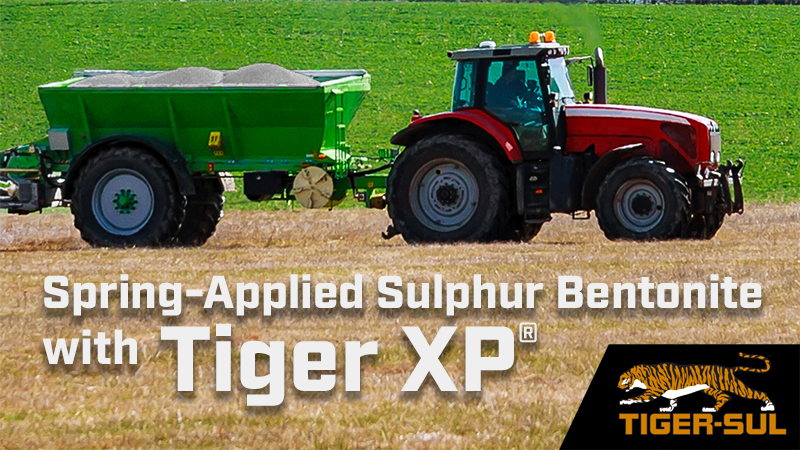Seed Treatment: How Biological Companies Conquered the ‘Snake Oil’ Image
We’ve come a long in this industry, from seeing chemical seed treatments strictly as a way to avoid replant to expecting their biological counterparts to work near-miracles.
“As we are pushing our yields even further, seed treatments are really not only a contributor to crop establishment but to overall plant health, so we don’t have diseases and pests that attack those plants early that continue to nibble on yield potential all season,” says Jim Pullins, Technical Sales Manager with Verdesian Life Sciences.

Fungicide/insecticide seed treatment only (left) vs. fungicide/insecticide plus Heads Up Plant Protectant (right).
Colin Dutcheshen, Vice President with Heads Up Plant Protectants in Saskatoon, SK, knows this well. With family roots in production agriculture, Dutcheshen explains, “Growing up on family farm in a small rural community, we were all too familiar with the here-today-gone-tomorrow snake-oil salesmen coming to town and promising remarkable products and product benefits, all guaranteed by a wink-wink and nudge-nudge sales pitch.”
Dutcheshen’s father, Joe, a pharmacist who also farmed 2,000 acres, knew the crops he was already growing had certain plant-extracted active ingredients, primarily triterpene glycosides, which were being tested to treat ailments from liver damage to melanoma back in the late 1990s.
Meanwhile, his neighbors were struggling with Rhizoctonia in their seed potato crops, making them worthless for export. The elder Dutcheshen came up with a theory: That these same plant-extracted biochemicals may also control crop disease.
“We knew the active was tested and proven in healthcare, so being farmers first, we had to take the product to the field. These chemistries turned out to have a significant effect,” his son tells CropLife® magazine.
By nailing down the mode of action — Systemic Acquired Resistance — the company’s signature product, Heads Up, went on to receive EPA registration in 2006 and PMRA registration in Canada in 2009 in a variety of crops. It is the only EPA/PMRA-registered seed treatment for suppression of both Sudden Death Syndrome (Fusarium virguliforme) and White Mold (Sclerotinia sclerotiorum) in soybeans.
“The industry has really promoted the control of Sclerotinia white mold only through fungicides in-crop, so we’re another tool in the toolbox to help growers prior to planting,” Dutcheshen adds.
Albaugh on ROI and Sustainability
Naturally, for most players in the value chain, efficacy and return on investment of biological seed treatments are the linchpin.
From that point, it’s all about compatibility and positioning with the company’s current synthetic fungicides and insecticides, says Jay Stroh, Biological Seed Treatment Lead with Albaugh. Seed and seedling safety and ease of use for both the retailer and grower are the final components.
“One thing about Albaugh is that we’re very transparent about what the products are. In the past it was kind of, ‘Trust me, these products work,’” Stroh tells CropLife. “When you tried to dig into what they were, a lot of times predecessor companies might not share that. With Albaugh, we want to make sure (customers) know exactly what’s in these products, how to use them, and how they work.”
Despite the tough ag economy, sales of Albaugh’s BioST Nematicide continue to grow, Stroh says. “Even though it’s a biological vs. a synthetic, we’ve got the history and performance of the product. In this environment, I think it all goes back to ROI.”
More and more customers continue to add to the sustainable solutions in their toolboxes. “This is driven a lot by the retail food industry, whether it be General Mills, Unilever, or Costco and others who are looking for sustainable products,” Stroh says.
While 95% of Albaugh’s market is conventional, the sustainable and organic segments are claiming bigger pieces of the pie. “We see those as new growth opportunities,” he says.
Albaugh’s biological seed treatment platform comprises the BioST Nematicide, BioST Insecticide, and BioST VPH Biostimulant. Several BioST fungicides are currently slated for EPA registration and commercial launch sometime in the near future, according to Stroh.
From Verdesian Life Sciences, Seed+ is a biological seed treatment for corn and soybeans, introduced in 2018. The product will upregulate 1,164 genes within any plant, the majority of which are geared to withstanding stress. “Having the ability to identify the activity of your product, where it works, why it works, and being able to explain it is a big advantage at getting these products accepted among farmers. It gives them the ability to make better choices,” says Pullins.
Also from Verdesian is Take Off ST, biological technology discovered by the Los Alamos National Laboratory in New Mexico. The cost-effective product accelerates a crop’s ability to utilize nitrogen leading to a faster start and high yield potential.
Keeping It Real
What is key to driving the success of many newer biological seed treatments? The answer is simple: realistic expectations, according to Kurt Seevers, Technical Development Manager for Seed Treatments and Inoculants with Verdesian Life Sciences.
“I think the market needs to understand that, with biologicals, we’re making strides, and we’re working to improve consistency of performance. But if somebody comes in and tells you a product is going to work in every situation, in every soil, on every kind of seed, your radar should be going on, and there ought to be doubt.”
Biological seed treatments would not capture a coveted part of the limited real estate on the seed if there wasn’t potential benefit, he points out. Seevers says that, in his experience, the crop shows a positive response from most biological products 65% to 75% of the time. In some locations and in some years, that number is higher. In any case, the odds are favorable.
While retailers’ acceptance of biological seed treatments has increased, education on this complex, broad category has often lagged. At Verdesian, in 2018 it launched Nutrient Use Efficiency (NUE) University. The online platform offers courses designed around specific areas, such as inoculants, that speak to what they are, how they work, and why they’re used, without mentioning a single product. Subsequent modules build on the intro courses with more detailed information and product specifics.
ABM, FMC Approaches
“I think the role of biological seed treatment is getting more and more important every day,” says Dan Custis, CEO of Advanced Biological Marketing Inc. “Our biggest competitor in the marketplace isn’t from a biological, it’s from the farmer that doesn’t use any of our products.”
One of ABM’s biological seed treatments is SabrEx product for corn, which is two strains of beneficial fungus Trichoderma. Over the past four years, the company has been conducting field tests on over 380 plots, resulting in an average yield increase of more than eight bushels per acre. Its Graph-Ex SA seed treatment for soybeans is comprised of three nitrogen-fixing bacteria (Bradyrhizobia) and Trichoderma that provide more efficient use of soil nutrients for the host plant. Growers have averaged a 4.51 bushels per acre advantage over untreated soybean plots.
ABM is also working with several companies (Custis declined to specify which ones) to combine a biological with an in-furrow liquid fertilizer and to put a biological inside the chemistry that goes on the seed. “Some of the opportunities are endless,” he says. However, he adds, “It’s surprising to me that today companies are still coming up with a ‘one-trick pony’ product. I’ve been approached by companies that want us to market their biological, but they don’t have at least a couple of years’ worth of third-party testing to support what they’re showing you.”
Kaustubh Borah, North America Plant Health Portfolio Leader and Business Development, FMC, shared how his company has approached the space.
FMC has prioritized development of toxicology packages and pursues EPA registration for products with claims of pesticidal activity, which helps differentiate it from competitors who often sell products labeled as biostimulants that are only assumed to provide activity against various pests.
“For FMC’s reputation and the name that we carry, we want to make sure we very clearly state what the claims are, so we go the whole nine yards,” Borah says. “The industry has seen a lot of biologicals coming into the marketplace that are not standing up to their performance claims. Some of it is because, in the past, companies might not have invested to understand the (science) behind where biologicals fit well in the application timeframe. We conduct global trials and look at soil types and environment to understand where biologicals are best positioned to be successful.”
On board for the soybean market in 2020 is FMC’s Avodigen (trademark pending), or F4018. The product has grown fast in Brazil under the brand names Quartzo and Presence and received EPA registration for seed treatment uses in mid-2018. Avodigen is a combination of two Bacillus strains repelling nematodes and is also active on Rhizoctonia and Fusarium.
Next up, the company expects to receive EPA approval in late 2020 for two active ingredient microbial pesticide strains, RTI 301 and RTI 477. The associated formulated products, which combine two Bacilli strains to control diseases such as Sudden Death Syndrome in soybeans as well as Fusarium, Rhizoctonia, and Phytophthora, are for seed treatment, in-furrow, and transplant application methods.







